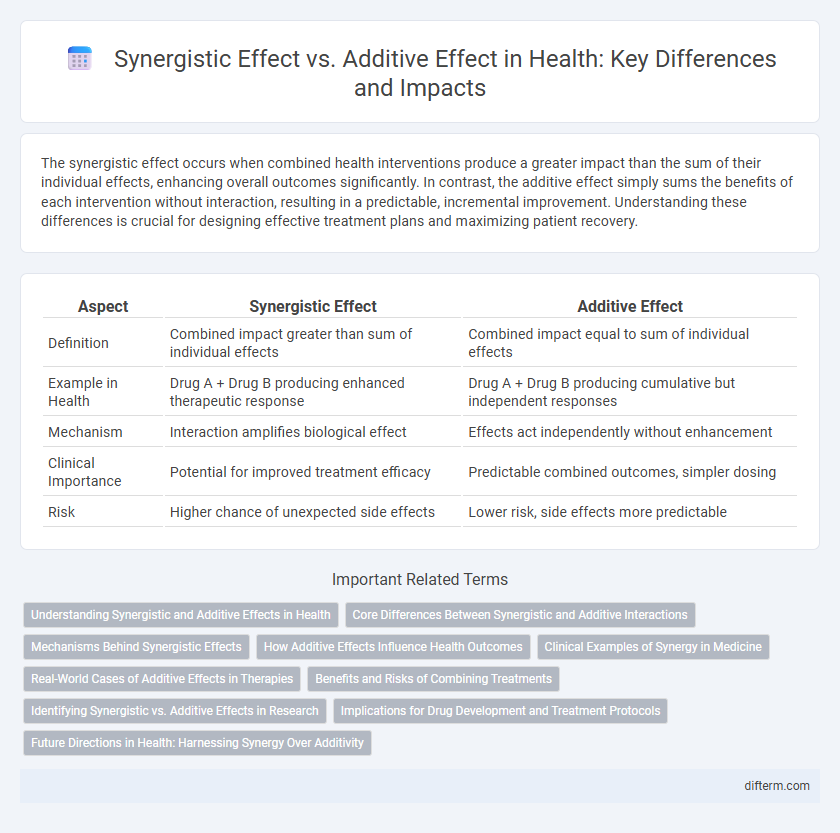The synergistic effect occurs when combined health interventions produce a greater impact than the sum of their individual effects, enhancing overall outcomes significantly. In contrast, the additive effect simply sums the benefits of each intervention without interaction, resulting in a predictable, incremental improvement. Understanding these differences is crucial for designing effective treatment plans and maximizing patient recovery.
Table of Comparison
| Aspect | Synergistic Effect | Additive Effect |
|---|---|---|
| Definition | Combined impact greater than sum of individual effects | Combined impact equal to sum of individual effects |
| Example in Health | Drug A + Drug B producing enhanced therapeutic response | Drug A + Drug B producing cumulative but independent responses |
| Mechanism | Interaction amplifies biological effect | Effects act independently without enhancement |
| Clinical Importance | Potential for improved treatment efficacy | Predictable combined outcomes, simpler dosing |
| Risk | Higher chance of unexpected side effects | Lower risk, side effects more predictable |
Understanding Synergistic and Additive Effects in Health
Synergistic effects in health occur when combined substances or interventions produce an outcome greater than the sum of their individual effects, enhancing therapeutic efficacy or toxicity. In contrast, additive effects result when the combined impact equals the sum of each agent's effect, reflecting simple cumulative action without interaction. Understanding these distinctions is crucial for optimizing drug combinations, nutritional strategies, and treatment protocols to maximize benefits and minimize risks.
Core Differences Between Synergistic and Additive Interactions
Synergistic effects occur when combined substances produce a greater impact than the sum of their individual effects, enhancing therapeutic outcomes or toxicity. Additive effects, by contrast, represent a simple summation of individual effects without amplification. Core differences include the magnitude of interaction, with synergistic interactions leading to amplified biological responses, while additive interactions maintain predictable, proportional effects.
Mechanisms Behind Synergistic Effects
Synergistic effects occur when combined substances interact through complementary biochemical pathways, enhancing each other's therapeutic impact beyond the sum of their individual effects. Mechanisms behind synergistic effects often involve receptor co-activation, signal amplification, and modulation of metabolic enzymes that increase bioavailability or efficacy. This contrasts with additive effects, where combined agents contribute independently without interaction at molecular or cellular levels.
How Additive Effects Influence Health Outcomes
Additive effects occur when the combined impact of two or more health interventions equals the sum of their separate effects, often improving treatment efficacy predictably. In chronic disease management, additive effects can enhance medication regimens by providing cumulative benefits without unexpected interactions. Understanding additive effects aids healthcare providers in designing optimized treatment plans that maximize health outcomes safely.
Clinical Examples of Synergy in Medicine
Synergistic effects in medicine occur when combined treatments produce a greater therapeutic outcome than the sum of their individual effects, exemplified by the use of beta-lactam antibiotics with beta-lactamase inhibitors to combat resistant bacterial infections. Chemotherapy regimens combining drugs like cyclophosphamide and doxorubicin demonstrate increased anticancer efficacy through distinct mechanisms acting on cancer cells simultaneously. Antiretroviral therapy for HIV commonly uses a synergistic drug combination, such as tenofovir and emtricitabine, to efficiently suppress viral replication and reduce drug resistance.
Real-World Cases of Additive Effects in Therapies
Real-world cases of additive effects in therapies often appear in cancer treatment, where combining chemotherapy agents results in cumulative tumor shrinkage without increased toxicity. In HIV management, using multiple antiretroviral drugs demonstrates additive viral suppression, improving patient outcomes more than monotherapy. These additive effects are crucial for enhancing therapeutic efficacy while maintaining manageable side effect profiles.
Benefits and Risks of Combining Treatments
Combining treatments can lead to a synergistic effect, where the therapeutic outcomes exceed the sum of individual effects, enhancing efficacy in managing complex health conditions such as cancer or chronic pain. However, additive effects, where treatments' benefits simply accumulate, may not provide significant improvement beyond each therapy alone but typically carry fewer risks. The benefits of synergistic interactions include reduced drug dosages and minimized side effects, while risks involve increased toxicity, drug interactions, and unpredictable patient responses requiring careful clinical monitoring.
Identifying Synergistic vs. Additive Effects in Research
Identifying synergistic versus additive effects in health research involves analyzing how combined interventions or compounds interact to enhance outcomes beyond their individual contributions. Synergistic effects occur when the combined impact is greater than the sum of individual effects, often assessed through statistical models like isobolograms or combination index methods. Accurate differentiation aids in optimizing therapeutic strategies and improving efficacy in treatments or drug development.
Implications for Drug Development and Treatment Protocols
Synergistic effects occur when combined drugs produce a greater therapeutic impact than the sum of their individual effects, enhancing efficacy and potentially reducing required dosages. Additive effects result when drug combinations yield a cumulative response equal to the sum of each drug's separate effects, offering predictable interactions for treatment design. Understanding these distinctions guides drug development by optimizing combination therapies, improving patient outcomes, and minimizing adverse effects in clinical protocols.
Future Directions in Health: Harnessing Synergy Over Additivity
Future directions in health emphasize harnessing the synergistic effect, where combined interventions produce outcomes greater than the sum of their parts, surpassing the additive effect seen with simply cumulative benefits. Emerging research in personalized medicine and multi-modal therapies aims to optimize these synergistic interactions at molecular, cellular, and systemic levels for enhanced treatment efficacy. Integrating advanced AI-driven analytics and precision health data will further enable identification and amplification of synergistic factors, transforming therapeutic strategies and patient outcomes.
Synergistic effect vs additive effect Infographic

 difterm.com
difterm.com